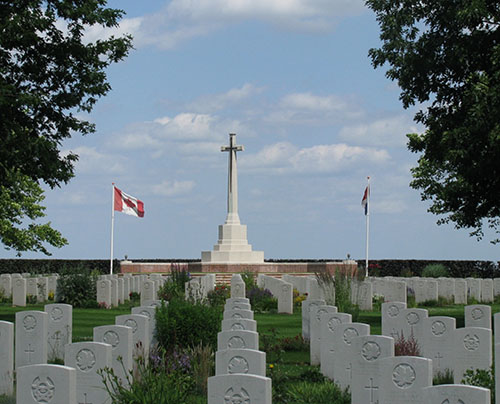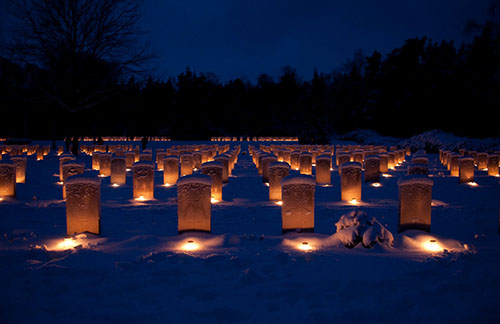



CLICK HERE TO HAVE YOUR RECYCLING PICKED UP AT YOUR DOOR!
Europe 2015: Adventure of a Lifetime! ![]() Europe 2015: Our 1,500km Journey Through History
Europe 2015: Our 1,500km Journey Through History ![]() Europe 2015: Sponsorship
Europe 2015: Sponsorship ![]() Europe 2015: Sponsor Hall of Fame
Europe 2015: Sponsor Hall of Fame
Scouts Recycle Initiative ![]() 2013 Canadian Jamboree
2013 Canadian Jamboree

Day Six: Canadian Liberation of the Netherlands - Groesbeek Canadian War Cemetary

On 5 May 1945, the Canadian General Charles Foulkes accepted the capitulation of German forces in the Netherlands after almost nine months of brutal combat with over 7,600 Canadian casualties. Canadians played the leading role in the liberation of the Netherlands, and the Dutch have never forgotten. Canada is revered in the Netherlands, and even to this day Dutch school children tend the graves of the Canadian soldiers who never made it home. Every year the Dutch Royal Family send thousands of tulip bulbs to Ottawa to remind Canadians that we are forever in the hearts and minds of the Dutch people.
The Groesbeek Canadian War Cemetery and Memorial is located about three kilometres north of the village of Groesbeek, Netherlands. The cemetery contains 2,338 Canadian soldiers of World War II. The cemetery is unique in that many of the dead were brought here from nearby Germany. It is one of the few cases where bodies were moved across international frontiers. It is believed that all fallen Canadian soldiers of the Rhineland battles, who were buried in German battlefields, were reinterred here (except for one who is buried in Reichswald Forest War Cemetery). General H.D.G. Crerar, who commanded Canadian land forces in Europe, ordered that Canadian dead were not to be buried in German soil.
Thousands of Dutch children tend the graves of the soldiers buried here as they do throughout the Netherlands.
Overview of the Canadian Liberation of the Netherlands
Watch this video from Veteran's Affairs Canada for an excellent understanding of Canada's Role => http://youtu.be/PzeuixDhsAw
Excerpts from veterans.gc.ca => The Battle of the Scheldt
In the months following D-Day, the Allies needed a reliable way to keep war supplies flowing to their forces on the European continent. To do this, they required a good seaport. The Belgian port of Antwerp was captured almost intact but it lay almost 80 kilometres from the sea and was accessible only by a long estuary where the shores were controlled by German forces. Much of this coastal area was Dutch and, in the fall of 1944, the First Canadian Army led the way in fierce combat under harsh conditions to clear the German occupiers from the shores of the Scheldt and open the waterway to vital shipping. More than 6,000 Canadian soldiers were killed, wounded or captured in this gruelling but victorious campaign that became a key step in the liberation of northwest Europe and the end of the war.
 The Netherlands' "Hunger Winter"
The Netherlands' "Hunger Winter"
In the fall of 1944, the Allies launched Operation Market-Garden, a daring land and airborne attack behind enemy lines in the eastern Netherlands. The goal was to bring the war to a rapid end by cutting in half the German positions in western Europe. The German resistance was fierce, however, and the bold offensive failed. It became apparent that the war would not end in 1944.
This would mean many more months of suffering for the Netherlands, which had already endured years of German occupation. The "Hunger Winter" of 1944-45 was a terrible time for the Dutch people. Food supplies were exhausted; many people were reduced to eating tulip bulbs just to try to survive. Fuel had run out and transportation was non-existent. By 1945, the official daily ration per person in the Netherlands was only 320 calories, about an eighth of the daily needs of an average adult. Thousands of Dutch men, women, and children perished of starvation and cold.
Canal by Canal, House by House
After three months of holding the front line in the Netherlands, the Canadians joined the final push to liberate the country. In February 1945, the First Canadian Army joined the Allies in a fierce push through mud and flooded ground to drive the Germans eastward out of the Netherlands and back across the Rhine.
In early April, the First Canadian Army (consisting of about 200,000 Canadians by this time, with tens of thousands more soldiers from other countries under its command) turned its attention north to clear the Germans from the northeast of the country. Often aided by information provided by Dutch resistance fighters, Canadian troops rapidly moved across the Netherlands, recapturing canals and farmland as they drove for the North Sea. Canadians also began to advance in the western Netherlands, which contained the major cities of Amsterdam, Rotterdam and The Hague. British and Canadian forces cleared the city of Arnhem in just two days by fighting a house-by-house battle. Only days later, they cleared Apeldoorn.
Canadian forces were prepared to continue their push in the west of the country, however, there were concerns this would prompt the now-desperate Germans to breach all the dykes and flood the country. To ease the pressure, and allow for a truce in late April, the Canadian advance in the western Netherlands came to a temporary halt. This allowed relief supplies to reach Dutch citizens who had almost reached the end of their endurance. To show their appreciation to the Canadians who air-dropped food during this time, many Dutch people painted, “Thank you, Canadians!” on their rooftops.
Through the hard work, courage and great sacrifices of Canadian and other Allied soldiers, the remaining German forces in the country surrendered on May 5, 1945, finally liberating all of the Netherlands. All German forces in Europe would surrender May 7, 1945. The next day was declared Victory in Europe (V-E) Day, marking the official end the Second World War in Europe.
 A Joyous Welcome
A Joyous Welcome
The Dutch people cheered Canadian troops as one town after another was liberated. This was a memorable time for the people of the Netherlands. Recalled one Dutch civilian who was a teenager at the time of the Canadian liberation of The Hague: “As the (Canadian) tank came nearer...there was a big hush over all the people, and it was suddenly broken by a big scream, as if it was out of the earth. And the people climbed on the tank...and they were crying. And we were running with the tanks and the jeeps all the way into the city.”
The Legacy
More than 7,600 Canadians gave their lives for freedom in the Netherlands and Canada would play another important role for the country. During the war, some members of the royal family of the Netherlands found sanctuary in Canada and, in 1943, Princess Margriet was born in a section of the Ottawa Civic Hospital that was temporarily made territory of the Netherlands so the princess could be born on Dutch ‘soil’. These powerful connections helped form warm bonds of friendship and respect between the Dutch and the Canadians which continue to this day. The evidence of this enduring connection may be seen in the tulips—gifts from the Netherlands—which bloom in Ottawa each spring and in the care and attention bestowed by the Dutch people on the burial places of our war dead. Even though the cost of lives was heavy and the sacrifice great, Canadians are proud to have been cast in the role of liberators.
Read the full story at veterans.gc.ca
We Need your Help!
Our visit to the Groesbeek Canadian War Cemetary does not yet have a sponsor! In return for your sponsorhip, we will take a picture (with your logo if you prefer) of our Scouts at the memorial, and we will also record a video of our youth thanking you by name from the site. In addition, you will be featured in our "Sponsor Hall of Fame", on our interactive map, and we will publically thank you through our social media channels encouraging the parents of our 100+ youth members to do the same.
All sponsors of our journey will also receive a certificate of thanks signed by all the youth who will be attending the trip.
We Work Hard for Our Donations!
 Scouts are not looking for a hand-out, we are looking for the opportunity to work for our donations. As much as we appreciate donations, we also really appreciate the opportunity to provide a service in exachange for the donation. Our adult and youth members are insured by Scouts Canada for service projects, and the onus would NOT be on your business/organization in the unlikely event of injury. We can clean parking lots, shovel snow, rake leaves, clean windows, chop wood, complete light-moderate manual labour, data-processing, painting, customer service, trail maintenance, trash clean-up, web design, photography, graphic design and really anything else you can think of. You will not only be providing a donation to help the youth experience a trip that will literally change the way they look at their place in the world but you will also be providing these same youth with real work experience and life skills.
Scouts are not looking for a hand-out, we are looking for the opportunity to work for our donations. As much as we appreciate donations, we also really appreciate the opportunity to provide a service in exachange for the donation. Our adult and youth members are insured by Scouts Canada for service projects, and the onus would NOT be on your business/organization in the unlikely event of injury. We can clean parking lots, shovel snow, rake leaves, clean windows, chop wood, complete light-moderate manual labour, data-processing, painting, customer service, trail maintenance, trash clean-up, web design, photography, graphic design and really anything else you can think of. You will not only be providing a donation to help the youth experience a trip that will literally change the way they look at their place in the world but you will also be providing these same youth with real work experience and life skills.
Sponsor our stop at Groesbeek Canadian War Cemetary
We are seeking a $1,000 donation to sponsor our trip to the Groesbeek Canadian War Cemetary.
Please contact us if you are able to help.
Click here to learn more about other ways you can help our youth!
Make a Donation to Support Our Scouts